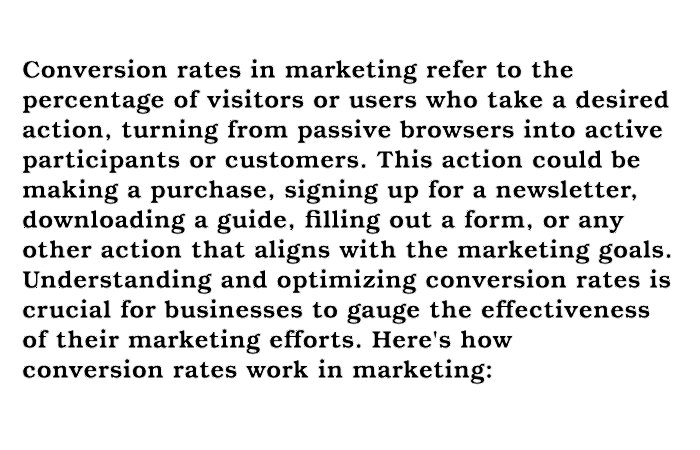Conversion Rates Marketing
Conversion rates in marketing refer to the percentage of visitors or users who take a desired action, turning from passive browsers into active participants or customers. This action could be making a purchase, signing up for a newsletter, downloading a guide, filling out a form, or any other action that aligns with the marketing goals. Understanding and optimizing conversion rates is crucial for businesses to gauge the effectiveness of their marketing efforts. Here's how conversion rates work in marketing:

Conversion rates in marketing refer to the percentage of visitors or users who take a desired action, turning from passive browsers into active participants or customers. This action could be making a purchase, signing up for a newsletter, downloading a guide, filling out a form, or any other action that aligns with the marketing goals. Understanding and optimizing conversion rates is crucial for businesses to gauge the effectiveness of their marketing efforts. Here's how conversion rates work in marketing:
1. Types of Conversion Rates:
- Sales Conversion Rate: Measures the percentage of website visitors who complete a purchase.
- Lead Conversion Rate: Tracks the percentage of leads (prospective customers) who become paying customers.
- Click-Through Rate (CTR): Measures the percentage of users who click on a specific link or ad compared to the total number of users
- who viewed it.
- Form Submission Rate: Measures the percentage of visitors who fill out a form on a website.
2. Importance of Conversion Rates:
- Conversion rates indicate the effectiveness of marketing strategies and the ability to turn visitors into customers or leads.
- They help in evaluating the performance of different campaigns, channels, or website pages to optimize and allocate resources
- effectively.
- Analyzing conversion rates allows businesses to identify areas for improvement in the sales funnel or user experience.
3. Factors Influencing Conversion Rates:
- User Experience (UX): The ease of navigation, clear calls-to-action, and optimized design can significantly impact conversion rates.
- Relevance of Offer: The relevance and attractiveness of the offer to the target audience affect their likelihood to convert.
- Website Performance: Slow loading times, technical glitches, or a complicated checkout process can deter conversions.
- Content Quality: Compelling and relevant content can motivate users to take action.
4. Optimizing Conversion Rates:
- A/B Testing: Testing different variations of ads, landing pages, or email content to identify what resonates best with the audience.
- Clear Call-to-Action (CTA): Having a clear and compelling CTA encourages users to take the desired action.
- Optimizing Landing Pages: Ensuring that landing pages are relevant, engaging, and user-friendly.
- Analyzing Data: Constantly monitoring and analyzing data to identify trends, patterns, and areas for improvement.
By understanding and optimizing conversion rates, businesses can enhance their marketing strategies, improve customer acquisition, and ultimately increase their return on investment (ROI).
What's Your Reaction?
















